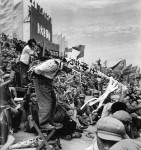14th September 2012
Frobisher Auditorium 2
Barbican Centre, Silk Street London EC2Y 8DS
Tickets: £8 online/ £10 on the door
Time: 7.00pm
For more information: 020 7638 4141/ tickets@barbican.org.uk
“I knew I had lots of “negative” frames, so I would quickly dry them and clip them off, to not let other people see them. The only fear I had was the others would complain that I was wasting public resources, shooting pictures that the newspaper couldn’t use — and I would leave the positive ones hanging to dry. I would put the “negative” negatives into brown envelopes in a secret compartment in my desk. In the spring of 1968, I sensed that I would be [searched] soon, I took batches of the negatives home every day after work. I sawed a hole in the parquet floor at home under desk and hid them there.
My wife stood at the window, watching out. I sawed the floor slowly, for over a week. It wasn’t like now when we have electric drills. I sawed it bit by bit. I needed to hide my things. My negatives, plus two Chiang Kai-shek and Yuan Shikai coins, my stamp collection which had images by Goya of naked women — they were all valuable. Not just my negatives.” (The New York Times Interview with Li Zhensheng)
On the 14th of September at the Barbican Centre Chinese photographer Li Zhensheng will be discussing with Robert Pledge, co-founder of Contact Press Images, the legacy of his unique photographic project that reveals the severe realities of life during the Great Proletarian Cultural Revolution (1966-76).
In 1965 Mao issued a rallying cry that began the Great Proletarian Cultural Revolution, an internal war which raged across China for a decade between 1966 and 1976. During these times children turned against parent and pupil against teacher; tens of thousands of young revolutionaries were mobilised as Red Guards, while countless others were executed, imprisoned or sent to work camps accused of being enemies of the masses.
Over the course of almost 20 years from 1963, Li Zhensheng worked for the Heilongjiang Daily, a Communist newspaper in Northern China. His unique archive of images conveys the madness of this time – its spectacular, stage-managed public trials, its recantations, its cult of personality, its mass demonstrations, its executions and its re-education campaigns – as seen through the eyes of an exceptional witness. Li Zhensheng was born in August 1940 and was initially full of revolutionary zeal and committed to Mao’s cause. He set up his own group of revolutionaries on the newspaper called “Red Youth Fighting Team”. They won official recognition from Beijing, and were sent red armbands inscribed with an ideogram from Mao translated as “red-colour news soldier” (i.e. “revolutionary journalist”).
Li fell victim to bitter political infighting and in 1968 was accused of being “petit-bourgeois” and a “foreign agent”. At the end of 1969 he was sent to a “re-education school” in a desolate rural region north of Harbin for two years. He returned to work in 1972 as head of photography at the Heilongjiang Daily, a position he maintained up until 1980. During these hard times Zhensheng took tremendous courage and risk, by hiding and preserving at least 30,000 negatives during the ten-year period, keeping them safe in his furniture and under his floorboards. Today, these pictures form the only known existing photographic documentation of the period, from Zhensheng’s unique eye.
Li Zhensheng’s work will be on display at the exhibition ‘Everything Was Moving: Photography from the 60s and 70s’ from the 13th of September at the Barbican along side a number of other photographers. More information on that exhibition will be coming up in an up ad coming post.
Information: Barbican











